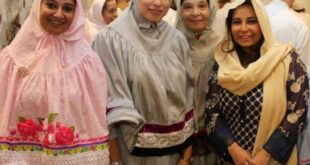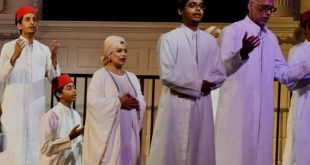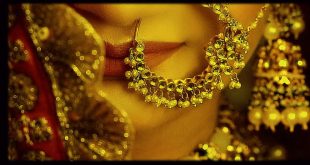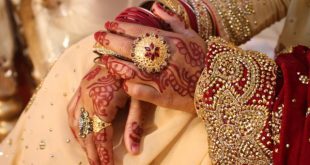The Malays of Sri Lanka who were brought over during the period of Dutch rule in the country, practice a number of traditional customs derived from both Islamic practice and long-cherished Malay cultural traditions that evolved in Indonesia and Malaysia. Here are the main ones marking the main landmarks of life.
BIRTH AND CHILDHOOD
The birth customs of the Malays are largely based on their Islamic faith.
Naming
The naming ceremony may be held on the seventh or fortieth day or within the first three months. Sometimes a feast, usually a lunch is given and the lebbe (religious officiant) names the child. Malays, both young and old, bear personal names of either Arabic or Malay origin, though the Arabic element predominates in the majority of cases. In the case of surnames however one notices that a good many such patronymics are of Malay or Sanskritic origin. It is said that in the olden days, the names given to Malay children at the naming ceremony on the fortieth day were kept a secret as they believed that they could be harmed by witch doctors. For instance, B.D.K.Saldin, the author of the book Portrait of a Sri Lankan Malay (2003) was named Tuan Singasiri at his naming ceremony but the name subsequently given as Baba Deen Kitchil Saldin. The Malays of former times are also said to have given names relating to events when a child was born. For instance, a person with the name Puasa meant that he was born during the fasting month. The name Selasa meant that the child was born on a Tuesday.
The Malays of former times had personal names like Bagus, Bintan, Kicil and Kassooma which may still be borne by the older generation. Such names are not without meaning. For instance, Kichil means ‘small’, Bagus ‘fine’ and Bintan ‘star’. One also still comes across typical Malay female names like Kartini, Hartini and Melati.
Even nowadays there are said to be those Malay parents who give their children Malay names like Azehari and Prawira for boys and Melati and Suratni for girls. But this does not hold true for the vast majority who still prefer names of Arabic origin. These include names like Aqeel, Saleem and Taslim in the case of males and Hafsa, Zeenat and Raihana in the case of females.
Ear piercing
The piercing of ears of girls is usually performed in early infancy and sometimes a feast, usually a lunch, may be given to mark the occasion. Malay women have been traditionally fond of ear ornaments which is seen from the fact that fancy ear-studs known locally as karabu actually originate from the Malay krabu or kerabu which meant ‘a flat, round ear-stud, usually of a large stone in a cluster of smaller stones’ or ‘small earrings of gold sometimes with a diamond set in them’
Circumcision
Circumcision is another important religious rite of Malays as among Muslims generally. Circumcision of boys is known here as sunnat and has traditionally taken place when they are about seven years of age or above, though nowadays boys may be circumcised early in infancy.
Girls are invariably circumcised in early infancy at the same time as they are named. This is performed by a traditional female practitioner usually on the fortieth day who visits the house, shaves the head of the girl and circumcises her. This procedure is usually a simple one and involves nicking the area of the prepuce covering the clitoris to draw a little blood, a cheap substitute for the Islamically prescribed procedure of removing the prepuce of the clitoris which is similar to the foreskin of boys removed at circumcision. In other Malay countries like Malaysia, Indonesia and Brunei, it is the proper procedure that is followed because it has been medicalized and offered in medical clinics as a package, usually together with ear-piercing.
Male circumcision o the other hand has been traditionally performed when the child was much older, usually seven or more and was much celebrated in the olden days as it was regarded as a rite of passage as well, not just a religious duty.
In the olden days, the boy to be circumcised would be bathed, dressed like a bridegroom and seated on a dais or makeshift throne before the guests assembled for the occasion. The boy would be seated thus wearing new clothes complete with the traditional Malay headgear, the songko. He would also go through a pachar ceremony where the elders anointed the palms of the boy with scent before he underwent the operation. It is said that in days gone by, the fingers and palms used to be smeared with henna, leaving behind a red stain. A mawlood would be recited and lunch or dinner served before the boy was circumcised by the Osta or barber.
The boy would be seated on a mortar placed upside down. One person would hold his hands from behind, and another would hold the legs apart while the Osta performed his task. It is said that in the olden days, the cries of the boy being circumcised were drowned by loud prayers or by music. The seraphina and tabla were used by the menfolk whilst the womenfolk played the rabana, a circular drum placed on small stilts around which about five or six women were seated. The women would squat around and beat it around the edges, the idea being to make as much noise as possible, so that any cries of the boy or boys being operated on would go unheard. Ash would be applied to the wound which would be covered with a little piece of white cloth while another would be used to tie it. The boy, having undergone the operation, would be placed on a mat and a white cloth suspended from the roof would be placed as a covering in such a manner that it does not come into contact with the wound. The celebrations would continue for seven days culminating in a visit to the mosque by the boy with his parents.
In the Hambantota District, there existed a practice where on the seventh day after the circumcision, the boy would be taken to the sea to bathe which would continue daily thereafter until such time the bandage dropped from his penis. On the seventh day after the bath, the boy would be attired in new clothes and a feast held with milk-rice (pachor), oil-cakes (chuchur) and bananas (pisang), the invitees being only the closest relatives. The procedure is now very often performed in hospitals, particularly in the urban areas.
WEDDING CUSTOMS
It would appear that in the olden days, early marriage was the norm, though nowadays it often happens that most Malay youth and girls marry in their late teens or their early twenties. It is said that in the olden days, the Malays used the services of an elderly couple, the Kakek Undang (Grandfather who invites) and Nenek Undang (Grandmother who invites) to convey invitations to weddings. This was followed a week later by the couple visiting the homes of the invitees once again and reminding them of the event, a practice known as mengulang. This custom is however no
longer practiced, with the wedding card having taken over the role.
Malay weddings are usually preceded by an engagement. This Malay engagement ceremony involves an exchange of rings known as chinching aratookaar) where the suitor and his party would pay a visit to the bride’s house with doolangs or trays of fruit and cakes. The suitor would place a ring on the girl’s finger on this occasion, though in the olden days this was done by the suitor’s mother or sister. The Dua Slamat comprising of the recitation of the Sooratul Fatiha (The Opening Chapter of the Qur’an) is then performed to invoke blessings on the couple who intend entering wedlock and this is followed by lunch or dinner. This serves as a confirmation of the marriage which will take place in the weeks to follow.
Another important pre-nuptial ceremony among the Malays of yore though not so much today was the pachar ceremony which was held shortly before the wedding. The ceremony involved the bride being attired in a colourful sari while her female relatives placed henna (pachar) on her palms to form little dots. This ceremony is however hardly if ever performed nowadays. Dowry is also known to figure among the Malays and this dowry known as msaka is usually given in a box by the bride’s parents to the groom, mostly on the registration day which may be held a few days or weeks before the wedding ceremony, often at the bridegroom’s residence. This is followed by a feast, usually a lunch or dinner.
Malay weddings on the other hand are traditionally held at the bride’s residence in the night. We were informed that in the olden days (until about the 1940s) in Hambantota, the bridegroom would be conducted in retinue to the bride’s house while those escorting him would sing pantungs (traditional Malay songs). This custom seems to have died out, though it is still the custom for the groom to be escorted to the bride as is also the case with the Moors. The groom’s father would escort him halfway to the throne after which he would be replaced by the bride’s father who would thereafter escort him to the bride. In traditional Malay marriages there exists a custom where the bride would be kept seated in the throne (istaal) holding in each hand a roll of betel leaf (seeri) inside which is placed some pieces of turmeric, jasmine flowers and a lime, ostensibly to ward away evil influences. The groom, upon arrival, would take these betel leaves from the bride’s hands and throw them over her head or shoulders. This being done, he would tie the tali or gold chain around her neck.
The tali of a Malay bride today usually consists of a gold chain with a pendant, though sometime back the pendant comprised of a crescent. In still earlier times, that is until about the 1940s, the tali of Malay brides comprised of a thick gold chain with half sovereigns all round it and a full sovereign as a pendant. There may also be occasions where the bride would bend down and touch the groom’s feet as a mark of submissiveness. This act is said to mean that her paradise lies at the feet of her husband. This practice is however deemed unislamic by religious Malays and is dying out since bowing down even symbolically is due to God and none other.
The couple would thereafter take their seats in the throne with the bride being seated on the left side of the groom. This is said to be symbolic of the fact that woman (Eve) was created from a rib taken from the left side of man (Adam) and therefore always has to be on the left side of her husband. Malay weddings may sometimes be accompanied with the beat of the rabana (large one-sided drum) and singing of pantungs (Malay songs) by the women.
FUNERAL RITES
Malay funeral rituals are like those of Muslims elsewhere very simple. A custom exists where a dish known as umping (rice flakes) and dates are served at the funeral after the burial. However the customs that follow may be more elaborate. Prayers are often recited at sunrise and sunset at the home of the deceased for forty days after the funeral, besides khatams or almsgivings conducted on the 3rd, 15th, 20th, 30th and the 40th day after death. The 40th day ceremony is the biggest of these functions and is held at night with the guests invited for dinner after the prayers are over. The closest relatives would keep up the whole night and shortly before sunrise, another service would be conducted. A special feature of this service is that a variety of fruits and sweetmeats are placed in the centre of the room where the people gather for prayers. Following the prayers, the food is taken to the kuburan or grave where prayers would again be recited, after which it is conveyed to the closest mosque and given to the Lebbe or Muadhdhin (Caller to Prayer) or distributed among the poor.
Picture shows traditional Malay bridal couple. The dress of the Malay bride of today is usually a white bridal dress with a face veil. The Malay bridegroom would be attired in a long-sleeved shirt and trousers, with a batik sarong draped around the waist. He would also wear the traditional Malay headgear known as songko and the traditional Malay kris knife tucked into the ceremonial sarong, but with its handle showing
Post Disclaimer | Support Us
Support Us
The sailanmuslim.com web site entirely supported by individual donors and well wishers. If you regularly visit this site and wish to show your appreciation, or if you wish to see further development of sailanmuslim.com, please donate us
 Donate
Donate
IMPORTANT : All content hosted on sailanmuslim.com is solely for non-commercial purposes and with the permission of original copyright holders. Any other use of the hosted content, such as for financial gain, requires express approval from the copyright owners.
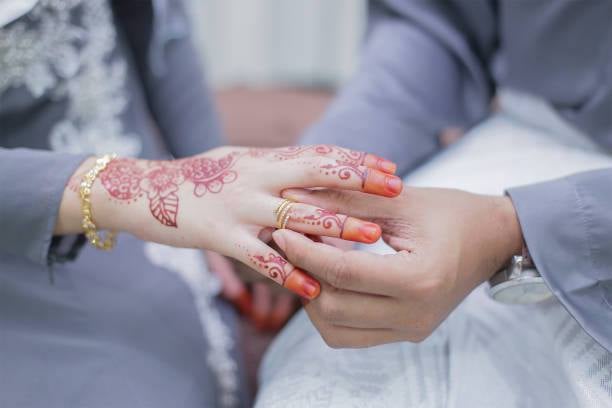
 Sri lanka Muslims Web Portal Sri Lanka Muslims News Center
Sri lanka Muslims Web Portal Sri Lanka Muslims News Center
 Donate
Donate